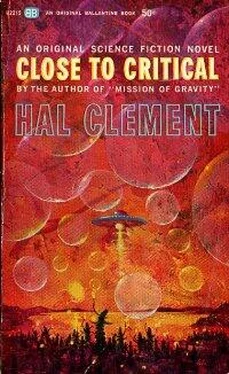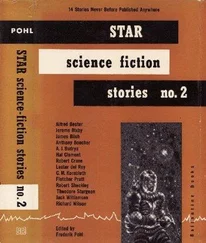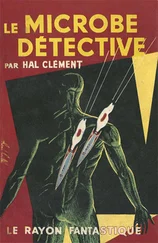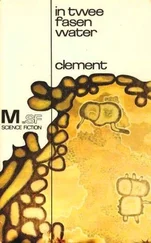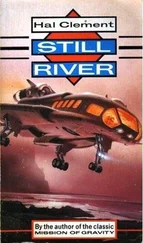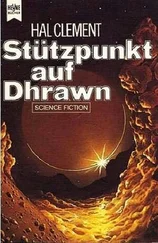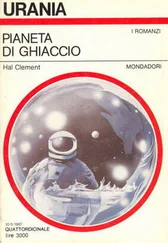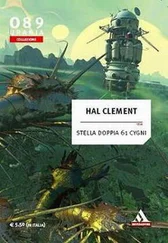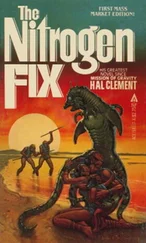Close to Critical
by Hal Clement
Sol, seen at a distance of sixteen light-years, is a little fainter than the star at the tip of Orion’s sword, and it could not have been contributing much to the sparkle in the diamond lenses of the strange machine. More than one of the watching men, however, got a distinct impression that the thing was taking a last look at the planetary system where it had been made. It would be a natural thing for any sentient and sentimental being to do, for it was already falling toward the great dark object only a few thousand miles away.
Any ordinary planet would have been glaringly bright at that range, for Altair is an excellent illuminator and was at its best right then: Altair is not a variable star, but it rotates fast enough to flatten itself considerably, and the “planet was in a part of its orbit where it got the maximum benefit from the hotter, brighter polar regions. In spite of this, the world’s great bulk was visible chiefly as a fuzzy blot not very much brighter than the Milky Way, which formed a background to it. It seemed as though the white glare of Altair were being sucked in and quenched, rather than illuminating anything.
But the eyes of the machine had been designed with Tenebra’s atmosphere in mind. Almost visibly the robot’s attention shifted, and the whitish lump of synthetic material turned slowly. The metal skeleton framing it kept pace with the motion, and a set of stubby cylinders lined themselves up with the direction of fall. Nothing visible emerged from them, for there was still too little atmosphere to glow at the impact of the ions, but the tons of metal and plastic altered their acceleration. The boosters were fighting the already fierce tug of a world nearly three times the diameter of distant Earth, and they fought well enough so that the patchwork fabrication which held them suffered no harm when atmosphere was finally reached.
The glitter faded out of the diamond eyes as the world’s great gas mantle gradually enfolded the machine. It was dropping slowly and steadily, now; the word cautiously might almost have been used. Altair still glowed overhead, but the stars were vanishing even to the hypersensitive pickups behind those lenses as the drop continued.
Then there was a change. Up to now, the thing might have been a rocket of unusually weird design, braking straight down to a landing on outboard jets. The fact that the jet streams were glowing ever brighter meant nothing; naturally, the air was growing denser. However, the boosters themselves should not have been glowing.
These were. Their exhausts brightened still further, as though they were trying harder to slow a fall that was speeding up in spite of them, and the casings themselves began to shine, a dull red. That was enough for the distant controllers; a group of brilliant flashes shone out for an instant, not from the boosters themselves but from points on the metal girders that held them. The struts gave way instantly, and the machine fell unsupported.
For only a moment. There was still equipment fastened to its outer surface, and a scant half-second after the blowoff of the boosters a gigantic parachute flowered above the falling lump of plastic. In that gravity it might have been expected to tear away instantly, but its designers had known their business. It held. The incredibly thick atmosphere—even at that height several tunes as dense as Earth’s—held stubbornly in front of the parachute’s broad expanse and grimly insisted on the lion’s share of every erg of potential energy given up by the descending mass. In consequence, even a gravity three times that of Earth’s surface failed to damage the device when it finally struck solid ground.
For some moments after the landing, nothing seemed to happen. Then the flat-bottomed ovoid moved, separating itself from the light girders which had held the parachute, crawled on nearly invisible treads away from the tangle of metal ribbons, and stopped once more as though to look around.
It was not looking, however; for the moment, it could not see. There were adjustments to be made. Even a solid block of polymer, with no moving parts except its outer traveling and handling equipment, could not remain completely unchanged under an external pressure of some eight hundred atmospheres. The dimensions of the block, and of the circuitry imbedded in it, had changed slightly. The initial pause after landing had been required for the distant controllers to find and match the slightly different frequencies now needed to operate it. The eyes, which had seen so clearly hi empty space, had to adjust so that the different index of refraction between the diamond and the new external medium did not blur their pictures hopelessly. This did not take too long, as it was automatic, effected by the atmosphere itself as it filtered through minute pores into the spaces between certain of the lens elements.
Once optically adjusted, the nearly complete darkness meant nothing to those eyes, for the multipliers behind them made use of every quantum of radiation the diamond could refract. Far away, human eyes glued themselves to vision screens which carried the relayed images of what the machine saw.
It was a rolling landscape, not too unearthly at first glance. There were large hills in the distance, their outlines softened by what might have been forests. The nearby ground was completely covered with vegetation which looked more or less like grass, though the visible trail the robot had already left suggested that the stuff was far more brittle. Clumps of taller growths erupted at irregular intervals, usually on higher ground. Nothing seemed to move, not even the thinnest fronds of the plants, though an irregular crashing and booming registered almost constantly on the sound pickups built into the plastic block. Except for the sound it was a still-life landscape, without wind or animal activity.
The machine gazed thoughtfully for many minutes. Probably its distant operators were hoping that life frightened into hiding by its fall might reappear; but if this were the case they were disappointed for the moment. After a time it crawled back to the remains of its parachute harness and played a set of lights carefully over the collection of metal girders, cables, and ribbons, examining them all in great detail. Then it moved away again, this time with a purposeful air.
For the next ten hours it quartered meticulously the general area of the landing, sometimes stopping to play its light on some object like a plant, sometimes looking around for minutes on end without obvious purpose, sometimes emitting sounds of varying pitch and loudness. This last always happened when it was in a valley, or at least not on the very top of a hill; it seemed to be studying echoes for some reason.
Periodically it went back to the abandoned harness and repeated the careful examination, as though it were expecting something to happen. Naturally, in an environment having a three hundred-seventy-degree temperature, about eight hundred atmospheres pressure, and a climate consisting of water heavily laced with oxygen and oxides of sulphur, things started to happen soon enough; and great interest was shown in the progress of the corrosion as it steadily devoured the metal. Some parts lasted longer than others; no doubt the designers had included different alloys, perhaps to check this very point. The robot remained in the general area until the last of the metal had vanished in slime.
At irregular intervals during this time, the surface of the ground shook violently. Sometimes the shaking was accompanied by the crashes which had first greeted the robot’s “ears”; at other times it was relatively silent. The operators must have been bothered by this at first; then it became evident that all the hills in the neighborhood were well rounded with no steep cliffs, and that the ground itself was free of both cracks and loose stones, so there was little reason to worry about the effect of quakes on the fabulously expensive mechanism.
Читать дальше
